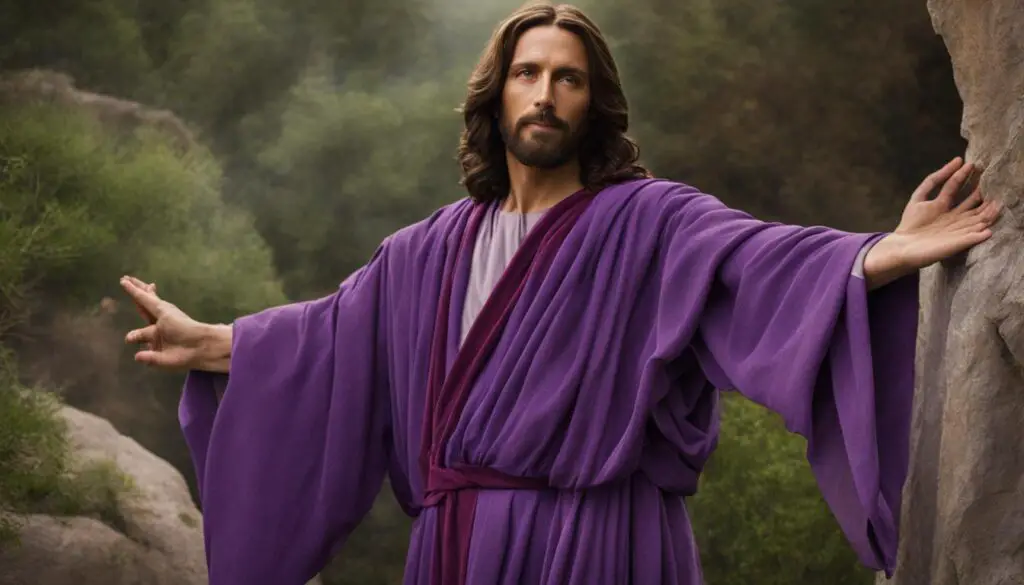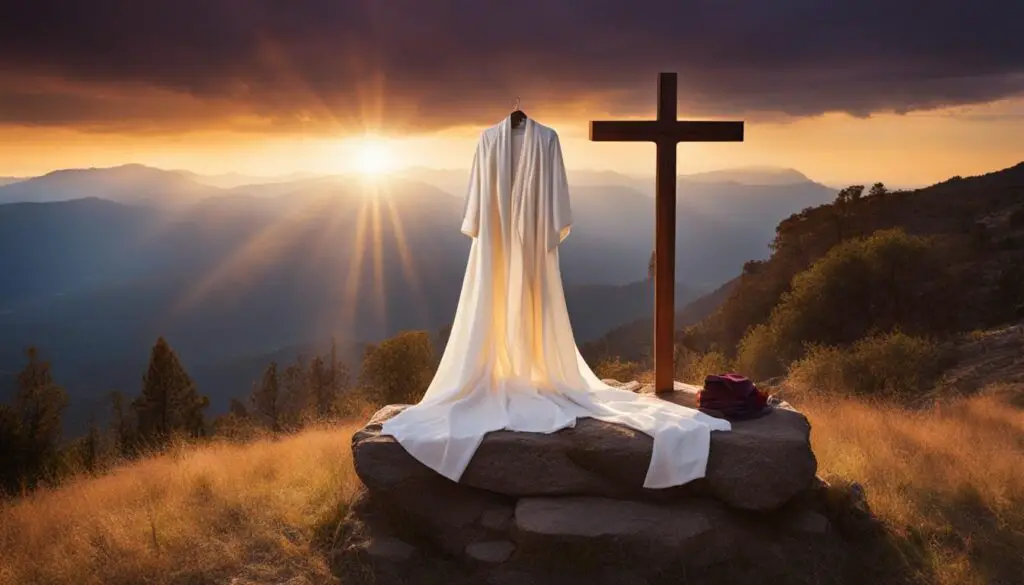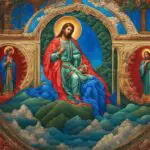Robes in the Bible hold a profound symbolism, representing spiritual purity and righteousness. The significance of robes can be found in various biblical references, shedding light on their meaning and importance.
Detailed Notes: Robes in the Bible carry deep spiritual symbolism, representing spiritual purity, righteousness, restoration, and salvation. From Joseph’s ornate robe to the white robes of the redeemed in heaven, robes serve as reminders of God’s love, favor, and provision. They signify the importance of genuine faith, avoidance of religious hypocrisy, and the ultimate experience of salvation through faith in Jesus Christ. Embracing the symbolic significance of robes enriches our understanding of biblical truths and deepens our spiritual journey.
Key Takeaways:
- Robes in the Bible hold symbolic meaning, representing spiritual purity and righteousness.
- Joseph’s ornate robe symbolized his father’s love and favor, while Jesus’ scarlet robe during his crucifixion was a mockery of his kingship.
- Robes also serve as protective coverings and ceremonial attire, signifying honor and authority.
- In the spiritual context, robes represent the righteousness and salvation provided through faith in Jesus Christ.
- Understanding the symbolic significance of robes deepens our understanding of biblical truths and enhances our spiritual journey.
Spiritual Meaning of Robe
The robe symbolizes the middle of the spiritual kingdom and represents the truth itself. In the Lord’s spiritual kingdom, the robe signifies the truths that exist in the middle. The spiritual kingdom is divided into three degrees: the inmost, the middle, and the external. The robe occupies the middle of this kingdom, connecting both the celestial and the natural. This division into three degrees is vital for perfection in heavenly matters, as seen in the three heavens and the three degrees of goods and truths. Similarly, man’s interiors, including the celestial, spiritual, and natural, are divided into three degrees. The robe reflects this divine order and completeness.
Within the middle of the spiritual kingdom, the robe holds a prominent position. It represents the truths that are the closest to the celestial and the most closely linked to the natural. The robe encompasses a vast range of spiritual concepts and teachings, serving as a bridge between different levels of understanding and knowledge. It is a reminder of the importance of seeking truth, embracing divine wisdom, and striving for spiritual perfection.
By understanding the spiritual meaning of the robe, we gain insight into the profound truths and principles that underlie its symbolism. It encourages us to explore the depths of spiritual knowledge and the divine order that governs the spiritual realm. Through the robe, we are reminded of the importance of truth, the interconnectedness of different levels of understanding, and the pursuit of spiritual perfection.
Table: Symbolic Significance of the Robe
| Symbolic Significance | Description |
|---|---|
| Middle of the spiritual kingdom | The robe represents the truths that exist in the middle of the spiritual kingdom, connecting the celestial and the natural. |
| Bridge between levels of understanding | The robe serves as a bridge between different levels of understanding, linking celestial wisdom to the natural world. |
| Vital for spiritual perfection | The division into three degrees, represented by the robe, is essential for achieving perfection in heavenly matters. |
| Reminder of the importance of truth | The robe reminds us of the significance of seeking truth, embracing divine wisdom, and striving for spiritual growth. |
The spiritual meaning of the robe goes beyond its physical appearance. It serves as a powerful symbol of the truths that exist within the spiritual kingdom, connecting different levels of understanding and guiding us towards spiritual perfection. By embracing the significance of the robe, we can deepen our understanding of spiritual principles and embark on a transformative journey of spiritual growth.
The Robe of Joseph
Joseph’s story in the Bible is marked by a significant symbol: his richly ornamented robe. Given to him by his father Jacob, this robe represented the deep love and favor his father had for him. It was a tangible expression of Jacob’s recognition of Joseph’s destiny, as well as a constant reminder of his father’s unwavering affection. The robe served as a powerful symbol of the restoration and fulfillment that Joseph would ultimately experience.
Despite the challenges Joseph faced, including being sold into slavery by his jealous brothers, the significance of the robe did not diminish. It held a sacred place in Joseph’s life, representing his father’s love and the destiny he was destined to fulfill. It was a symbol of hope and a reminder that no matter the circumstances, restoration and divine purpose would prevail.
In due time, Joseph’s restoration came to pass, as he rose to a position of great authority in Egypt. The robe played a central role in the fulfillment of Joseph’s destiny, reminding us of the power of love, faith, and God’s sovereign plan. Just as Joseph experienced restoration and fulfillment, we too can trust in the faithfulness of God and His ability to bring about our own restoration and purpose.

Table: Symbolism of Joseph’s Robe
| Symbolism | Description |
|---|---|
| Father’s Love | The robe represented Jacob’s deep love and favor for Joseph. |
| Destiny | The robe symbolized the destiny Joseph would fulfill in God’s plan. |
| Restoration | Despite the challenges, the robe served as a symbol of hope for Joseph’s ultimate restoration. |
| Fulfillment | In due time, Joseph experienced the fulfillment of his destiny. |
Robes of Sorrow and Pretension
The use of robes in biblical narratives goes beyond the representation of spiritual purity and righteousness. In certain instances, robes carry a profound message of sorrow and pretension. Job, in the midst of his suffering, tore his robe as an expression of deep sorrow and anguish. This act symbolizes the pain caused by the loss of earthly treasures and relationships.
The tearing of Job’s robe serves as a reminder not to let sorrow separate us from the love and fellowship with God. It is a poignant example of how even in the face of immense suffering, it is important to remain steadfast in our faith and trust in God’s plan.
“He tore his robe and shaved his head in grief, and then he fell to the ground and worshiped.” – Job 1:20 (NLT)
On the other hand, Jesus warned about the religious leaders who wore long robes, using their appearance to project an image of piety and knowledge of God. However, behind their outward display of righteousness, these religious pretenders rejected Jesus and deceived themselves and others. This serves as a cautionary tale, reminding us of the importance of genuine faith and avoiding religious hypocrisy.
Let us not be swayed by external appearances, but instead, focus on developing a true and genuine relationship with God, free from pretension and hypocrisy.
A table further illustrates the contrasting meanings and contexts associated with torn robes and long robes:
| Torn Robes | Long Robes |
|---|---|
| Symbolize sorrow and loss | Used to project piety and knowledge of God |
| Reminder not to let sorrow separate us from God | Exemplifies religious pretension and hypocrisy |
| Reflects genuine emotional response | Highlights the importance of genuine faith |
Through the narratives of torn robes and the warning against religious pretension, the Bible encourages us to embrace authenticity in our relationship with God, allowing genuine sorrow and faith to guide us on our spiritual journey.
The Robe of Mockery
During Jesus’ crucifixion, the soldiers mockingly clothed Him in a scarlet or purple robe, imitating a royal garment. This act of mockery reflects the disdain some people show towards Jesus instead of placing their trust in Him. It serves as a reminder to trust in Jesus and acknowledge His true kingship, rather than mocking or rejecting Him.
Jesus, the Son of God, came to earth to bring salvation and reconcile humanity with God. However, His message was met with skepticism and hostility by some. As the soldiers dressed Him in a scarlet or purple robe, they mocked His claim to be the King of the Jews. Little did they know that Jesus is indeed the King of kings and the Lord of lords, deserving of our trust and reverence.
In the midst of this mockery, Jesus remained steadfast in His mission to save mankind. He endured the humiliation and suffering, all because of His deep love for humanity. Despite the scorn and ridicule, Jesus demonstrated unwavering trust in the Father’s plan, even to the point of sacrificing His own life on the cross. His scarlet or purple robe, a symbol of mockery, serves as a powerful reminder to trust in Him, for He is the only way to true salvation and eternal life.

As we reflect on the robe of mockery, let us remember the significance of trust in our own lives. Just as Jesus trusted the Father’s plan, we too should place our trust in Him. In times of doubt or difficulty, let us lean on His promises and have faith that He is working all things together for our good. By trusting in Jesus, we can experience the fullness of His love, grace, and salvation.
The Best Robe of Righteousness
One of the most significant and poignant examples of the symbolic importance of robes in the Bible can be found in the parable of the prodigal son. This parable, shared by Jesus, tells the story of a young man who squanders his inheritance in a faraway land and eventually finds himself destitute and longing for his father’s forgiveness. When the prodigal son returns home, seeking reconciliation and restoration, his father embraces him and clothes him with the best robe, a symbol of honor, acceptance, and love. This best robe represents the righteousness that is bestowed upon those who repent and turn to God, regardless of their past mistakes or waywardness.
This act of clothing the prodigal son with the best robe is a powerful image of restoration and salvation. It highlights the grace and mercy of God, who extends forgiveness and offers a fresh start to all who come to Him in repentance and faith. It emphasizes that righteousness and salvation are not achieved through our own efforts or merits but are received as gifts from God through faith in Christ.
Moreover, the best robe signifies the complete restoration of the prodigal son’s position as a beloved member of the family. It signifies not only the forgiveness of his past but also the future hope of a new life in the embrace of his loving father. In this parable, the best robe serves as a visual representation of the transformative power of God’s love and the hope that comes with being reconciled to Him.

Table: The Symbolism of the Best Robe in the Parable of the Prodigal Son
| Symbol | Meaning |
|---|---|
| Best Robe | Righteousness and honor |
| Clothing | Restoration and reconciliation |
| Father’s Love | Unconditional forgiveness and acceptance |
| New Life | Hope and a fresh start |
This parable serves as a powerful reminder that no matter how far we may have strayed or how unworthy we may feel, God’s love is always ready to receive us with open arms. The best robe of righteousness is a symbol of the incredible grace and love that God extends to each of us, offering us the opportunity for restoration, forgiveness, and eternal salvation.
The White Robe of the Redeemed
In the book of Revelation, a vision reveals a multitude of people from every nation, race, and language standing before the throne of God, adorned in white robes. These white robes symbolize the redeemed, those who have been purchased by the precious blood of the Lamb. It is through the sacrificial death and resurrection of Jesus Christ that these blood-washed saints find their heavenly glory and salvation.
White, often associated with purity and righteousness, represents the cleansing and forgiveness received through faith in Jesus Christ. The white robe signifies the complete transformation and purification of those who have accepted Christ as their Savior. It is a visual reminder of their redeemed status, washed clean from sin and made worthy to stand in the presence of God.
As we reflect on the white robe of the redeemed, it serves as a powerful testament to God’s grace and mercy. It reminds us of the incredible price paid for our salvation and the eternal hope we have in Christ. Let us embrace the white robe of righteousness and live as blood-washed saints, walking in the light of God’s love and sharing the message of salvation with those around us.

The Symbolism of the White Robe
“They shall hunger no more, neither thirst anymore; the sun shall not strike them, nor any scorching heat. For the Lamb in the midst of the throne will be their shepherd, and he will guide them to springs of living water, and God will wipe away every tear from their eyes.” – Revelation 7:16-17
The white robe is a representation of the glorious destiny that awaits the redeemed in eternity. It signifies their eternal rest, satisfaction, and protection from the trials and tribulations of the world. It is a promise of divine guidance and provision, as the Lamb of God shepherds them to sources of everlasting life and sustenance.
By donning the white robe, the redeemed are set apart as holy and blameless before God. They are clothed in the righteousness of Christ, made worthy to enter into the presence of the Almighty. In this heavenly attire, they find peace, joy, and complete fulfillment, with every tear wiped away by God’s tender hand.
| Symbolism of the White Robe | Meaning |
|---|---|
| Purity | The white robe represents the purity and righteousness bestowed upon the redeemed through faith in Jesus Christ. |
| Redemption | The white robe symbolizes the redemption and salvation obtained through the sacrificial death and resurrection of Jesus Christ. |
| Divine Protection | The white robe serves as a protective covering, shielding the redeemed from the trials and tribulations of the world. |
| Hope and Eternal Rest | The white robe represents the ultimate destiny of the redeemed, a place of eternal peace, rest, and satisfaction. |
| Divine Guidance and Provision | The white robe signifies the guidance and provision of the Lamb of God, leading the redeemed to everlasting life and sustenance. |
As we anticipate the glorious fulfillment of the white robe in heaven, let us hold fast to the hope and salvation found in Jesus Christ. May we live each day as blood-washed saints, clothed in the righteousness of our Savior, and sharing the message of redemption with a world in need.
Robes as Protective Covering
In the Bible, robes served as more than just a garment for clothing. They carried symbolic meanings and represented various aspects of spirituality and righteousness. One such significance of robes can be found in the story of Adam and Eve.
After Adam and Eve sinned, God provided them with coats of skin as a protective covering. These coats of skin served not only to cover their physical bodies but also as a symbol of God’s care and provision. Unlike animals, humans do not naturally have fur or scales, making garments necessary for protection and warmth.
Robes, as outer garments, have historically been associated with royalty, nobility, and the wealthy. They signify high social distinction and are often worn during ceremonial occasions. The use of robes in such contexts reflects their symbolic importance, representing dignity, regality, and elegance.
The Significance of Protective Coverings
Table: Symbolic Meaning of Robes as Protective Coverings
| Symbolic Meaning | Explanation |
|---|---|
| Protection | The coats of skin provided by God served as a physical protection for Adam and Eve. |
| Provision | God’s act of providing coats of skin demonstrated His care and provision for His creation. |
| Sign of God’s Love | The protective coverings were a tangible reminder of God’s love and mercy towards Adam and Eve, even after their disobedience. |
| Separation from Sin | The coats of skin symbolized a separation from sin and a pathway to restoration and redemption. |
The use of robes as protective coverings not only has a practical purpose but also carries deep spiritual symbolism. It reminds us of God’s provision, His love, and His desire to separate us from sin and bring us into a place of restoration and redemption.
The Symbolic Importance of Robes
Robes hold a symbolic importance in biblical context, representing dignity, regality, and elegance. Throughout history, robes have been associated with high social distinction and have been worn by priests, nobles, and kings during ceremonial occasions. Their ornate designs and luxurious fabrics enhance their symbolic significance, reflecting the wearer’s position and the grandeur of the event. The symbolism of robes goes beyond mere clothing; it represents the authority, honor, and status bestowed upon the wearer.
The regal nature of robes can be seen in the meticulous attention to detail given to their design. Elaborate patterns, intricate embroidery, and precious materials are commonly used in creating these garments, further enhancing their symbolic meaning. The ornateness of robes conveys a sense of richness and power, reflecting the elevated position of the wearer and the significance of the occasion.
“The robe symbolizes not only the external appearance but also the inner qualities of the person wearing it. It embodies a sense of dignity and respect, commanding attention and reverence from others.”
The elegance of robes is evident in their flowing, graceful silhouettes. The loose and draping nature of these garments adds to their regal charm, exuding a sense of sophistication and grace. The choice of fabric, such as silk or velvet, further accentuates the elegance of the robes, giving them a luxurious and opulent feel.
The Symbolic Importance of Robes in Different Cultures
Robes hold symbolic significance not only in biblical context but also in various cultures around the world. In Asian cultures, traditional robes such as the kimono or hanbok represent cultural heritage, family ties, and social status. The colors, patterns, and designs of these robes convey specific meanings and reflect the values and traditions of the respective cultures.
Similarly, in Western cultures, robes have been associated with authority and prestige. Judges, academics, and ceremonial officials often wear robes to signify their position and the gravity of their roles. The use of robes in these contexts reinforces the idea of dignity, formality, and respect for tradition.
| Culture | Symbolism |
|---|---|
| Asian | Family ties, social status, cultural heritage |
| Western | Authority, prestige, formality |
Overall, the symbolic importance of robes transcends cultural boundaries and time periods. Whether in religious ceremonies, cultural traditions, or formal occasions, robes represent dignity, regality, and elegance, commanding respect and reflecting the elevated status of the wearer.
The Robe of Righteousness and Salvation
In the Bible, the metaphorical garments of salvation and the robe of righteousness hold immense significance for believers. These garments symbolize God’s provision, favor, healing, and deliverance. By accepting the sacrifice of God’s Son, Jesus Christ, and aligning with His righteousness, individuals receive the gift of salvation and are clothed in the garments of God’s grace and redemption. Through these symbolic robes, believers experience the transformative power of God’s love and mercy.
Just as clothing provides protection and warmth, these garments of salvation and righteousness offer spiritual covering and security. They represent God’s provision to guide and sustain us through life’s challenges, offering a refuge in times of trouble. The robe of righteousness, in particular, signifies the imputed righteousness of Christ that believers receive through faith. It is a tangible representation of our restored relationship with God and our position as His beloved children.
Moreover, these robes of salvation and righteousness bring healing and deliverance. They symbolize the divine transformation that occurs when individuals surrender their lives to Jesus and embrace His redemptive work. These garments cloak believers with hope, joy, and the assurance of eternal life. They serve as a constant reminder of God’s faithfulness, grace, and the promise of everlasting salvation.

Table: Symbolism of the Robe of Righteousness and Salvation
| Symbol | Meaning |
|---|---|
| Garments of Salvation | God’s provision, favor, and refuge |
| Robe of Righteousness | Imputed righteousness through faith |
| Healing and Deliverance | Transformation and restoration in Christ |
| Eternal Life | Assurance of salvation and the promise of everlasting life |
Conclusion
Robes in the Bible carry deep spiritual symbolism, representing spiritual purity, righteousness, restoration, and salvation. These garments hold significant meaning in various biblical contexts, shedding light on their importance in our faith journey.
The robe serves as a reminder of God’s love, favor, and provision. From Joseph’s ornate robe symbolizing his destiny and his father’s love to the white robes worn by the redeemed in heaven, robes are a powerful symbol of God’s redemption and salvation.
Understanding the spiritual symbolism of robes enriches our understanding of biblical truths and deepens our connection with God. It reminds us of the importance of genuine faith and the avoidance of religious hypocrisy. Ultimately, it points to the ultimate experience of salvation through faith in Jesus Christ.
As we embrace the symbolic significance of robes, let us be reminded of the spiritual journey we are on, seeking righteousness and redemption in God’s unwavering love. The robes in the Bible reflect the divine plan for our lives and the hope we have in salvation.
FAQ
What do robes symbolize in the Bible?
Robes in the Bible symbolize spiritual purity and righteousness.
What is the spiritual meaning of a robe?
The robe represents the middle of the spiritual kingdom and the truth itself.
What is the significance of Joseph’s robe?
Joseph’s robe symbolized his father’s love, favor, and the destiny he would fulfill.
How are robes associated with sorrow and pretension?
Robes can symbolize sorrow, as seen when Job tore his robe, and pretension, as warned by Jesus in relation to the scribes who wore long robes.
What is the significance of the robe of mockery?
The soldiers mockingly clothed Jesus in a scarlet or purple robe to imitate a royal garment, reflecting the disregard some people show towards Jesus.
What does the best robe represent in the story of the prodigal son?
The best robe symbolizes restoration and honor, representing the righteousness received through faith in Christ.
What do white robes signify in the book of Revelation?
The white robes represent the redeemed, those who have accepted Christ’s salvation and have been cleansed through His sacrifice.
Why were coats of skin provided to Adam and Eve?
God provided coats of skin as protective coverings for Adam and Eve after they sinned, symbolizing the need for garments for protection and warmth.
What is the symbolic importance of robes?
Robes symbolize dignity, regality, and elegance, often associated with high social distinction and ceremonial attire.
What does the robe of righteousness and salvation represent?
The metaphorical robe of righteousness represents God’s provision, favor, healing, and deliverance through faith in Jesus Christ.







